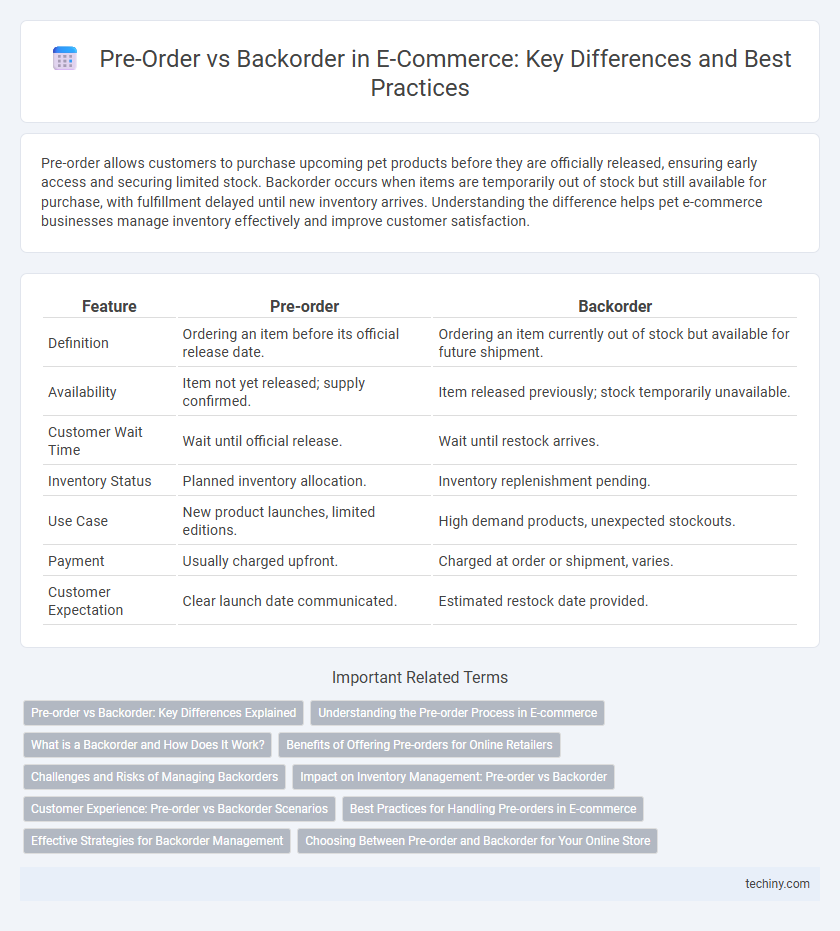Pre-order allows customers to purchase upcoming pet products before they are officially released, ensuring early access and securing limited stock. Backorder occurs when items are temporarily out of stock but still available for purchase, with fulfillment delayed until new inventory arrives. Understanding the difference helps pet e-commerce businesses manage inventory effectively and improve customer satisfaction.
Table of Comparison
| Feature | Pre-order | Backorder |
|---|---|---|
| Definition | Ordering an item before its official release date. | Ordering an item currently out of stock but available for future shipment. |
| Availability | Item not yet released; supply confirmed. | Item released previously; stock temporarily unavailable. |
| Customer Wait Time | Wait until official release. | Wait until restock arrives. |
| Inventory Status | Planned inventory allocation. | Inventory replenishment pending. |
| Use Case | New product launches, limited editions. | High demand products, unexpected stockouts. |
| Payment | Usually charged upfront. | Charged at order or shipment, varies. |
| Customer Expectation | Clear launch date communicated. | Estimated restock date provided. |
Pre-order vs Backorder: Key Differences Explained
Pre-order and backorder both involve purchasing products not immediately available, but pre-orders allow customers to buy items before official release dates, ensuring early access and often exclusive offers. Backorders occur when in-stock products sell out, and customers wait for restocking, which can lead to unpredictable shipping times and potential delays. Understanding these distinctions helps e-commerce businesses optimize inventory management and enhance customer satisfaction by setting clear expectations.
Understanding the Pre-order Process in E-commerce
Pre-order in e-commerce allows customers to purchase products before they are officially released, ensuring early access and securing inventory ahead of public availability. This process involves listing upcoming items with expected release dates, enabling businesses to gauge demand and manage production accordingly. Efficient pre-order systems improve cash flow, reduce stockouts, and enhance customer satisfaction by providing clear timelines and exclusive offers.
What is a Backorder and How Does It Work?
A backorder occurs when a customer places an order for a product that is temporarily out of stock but expected to be restocked soon. The retailer accepts the order and ships the item once inventory is replenished, often updating customers on estimated fulfillment dates. This process helps maintain sales flow despite supply chain delays, ensuring products remain available to consumers even during inventory shortages.
Benefits of Offering Pre-orders for Online Retailers
Offering pre-orders enables online retailers to gauge customer demand before committing to large inventory purchases, reducing the risk of overstock and minimizing storage costs. This strategy improves cash flow by collecting payments upfront, which can be reinvested into marketing or product development. Pre-orders also enhance customer engagement and loyalty by providing exclusive early access to new or limited-edition products.
Challenges and Risks of Managing Backorders
Managing backorders in e-commerce involves several challenges, including inventory inaccuracies and delayed fulfillment, which can lead to customer dissatisfaction and increased churn rates. The risk of overselling products unavailable in stock requires robust inventory management systems and real-time updates to prevent negative customer experiences. Effective communication and transparent policies are essential to mitigate these risks and maintain trust during extended delivery periods.
Impact on Inventory Management: Pre-order vs Backorder
Pre-order allows customers to purchase products before they are available, enabling businesses to forecast demand and optimize inventory levels accordingly. Backorder occurs when items are temporarily out of stock, requiring real-time inventory updates to manage delayed shipments and customer expectations. Effective inventory management systems must differentiate between pre-order and backorder statuses to maintain accurate stock levels, reduce holding costs, and improve supply chain efficiency.
Customer Experience: Pre-order vs Backorder Scenarios
Pre-order allows customers to secure products before they are officially released, creating anticipation and enhancing trust by offering clear delivery timelines. Backorder occurs when items are temporarily out of stock after purchase, often leading to uncertainty and potential delays in fulfillment. Optimizing communication and setting realistic expectations in both pre-order and backorder scenarios significantly improves overall customer satisfaction and retention.
Best Practices for Handling Pre-orders in E-commerce
Implement clear communication for pre-order timelines and expected delivery dates to manage customer expectations effectively. Use automated inventory management systems to track stock levels and update pre-order availability in real-time. Offer incentives such as discounts or exclusive early access to encourage pre-orders while ensuring transparent refund policies to build trust.
Effective Strategies for Backorder Management
Effective backorder management in e-commerce hinges on clear communication, accurate inventory forecasting, and flexible fulfillment options to maintain customer trust and minimize lost sales. Implementing automated notifications and estimated delivery times helps keep customers informed, reducing frustration and cancellations. Leveraging data analytics to predict demand and coordinating with suppliers ensures timely restocking and smoother order processing during backorder periods.
Choosing Between Pre-order and Backorder for Your Online Store
Choosing between pre-order and backorder for your online store hinges on managing customer expectations and inventory flow. Pre-orders generate buzz and guarantee sales before stock arrives, ideal for new or limited products, while backorders allow continuous sales after stock depletion, maintaining revenue streams. Analyze product demand, supply chain reliability, and customer patience to optimize fulfillment strategy and enhance overall shopping experience.
Pre-order vs Backorder Infographic

 techiny.com
techiny.com